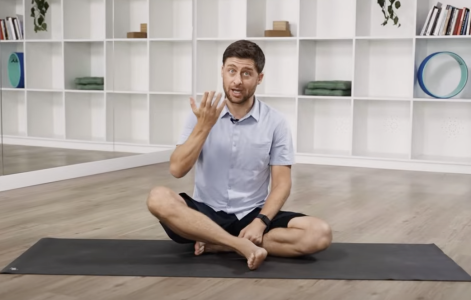How long will you live? Take this surprising test to find out, according to science
- Replies 0
How long will you live? It’s a question that’s crossed all our minds at one point or another—usually while blowing out birthday candles or after a particularly creaky morning getting out of bed.
While no one has a crystal ball, science is getting closer to offering some clues. And, believe it or not, one of the most telling predictors of longevity doesn’t require a fancy blood test or a trip to the doctor’s office.
All you need is a patch of floor and a willingness to give your knees a little workout.
Introducing: The Sitting-to-Rising Test
Forget tarot cards and palm readings. The latest research out of the European Journal of Preventive Cardiology suggests that your ability to sit down on the floor and stand back up—without using your hands, knees, or any other body part for support—may offer a sneak peek into your future health and longevity.
Here’s how it works: Stand upright, then lower yourself to a seated position on the floor. Now, stand back up. The catch? You can’t use your hands, knees, elbows, or the side of your legs for help.
Each time you do, you lose a point. Wobble a bit? That’s half a point gone. The highest possible score is 10 (five for sitting, five for rising), and the lower your score, the more it may signal underlying health issues.

The Science Behind the Sit
This isn’t just a party trick. In a study tracking over 4,200 adults aged 46 to 75 for more than a decade, researchers found a striking connection between test scores and survival rates.
Twelve years after the initial test, those who scored perfectly were overwhelmingly still alive. In contrast, less than half of those who scored between 0 and 4 were still with us.
What’s going on here? The sitting-to-rising test is a quick check of your non-aerobic fitness—think balance, muscle strength, flexibility, and coordination. These are the unsung heroes of healthy aging, often overlooked in favor of aerobic fitness (like walking or swimming).
But as Dr. Claudio Gil Araújo, the study’s lead author, points out, these qualities are just as vital for keeping us independent and resilient as we age.
Why Does This Test Matter?
You might be thinking, “I can’t remember the last time I sat on the floor, let alone got up without groaning!”
But that’s exactly the point. The ability to move from the floor to standing is a powerful indicator of your overall physical health. It’s not just about muscles—it’s about balance, joint health, and even your body’s ability to coordinate complex movements.
In fact, other research backs this up. A separate study found that people who couldn’t balance on one foot for 10 seconds were nearly twice as likely to die within the next decade compared to those who could. These simple tests are like a check engine light for your body, signaling when it might be time to tune up your fitness routine.
What If You Struggle With the Test?
Don’t worry—this isn’t a pass/fail exam, and it’s never too late to improve. If you find yourself reaching for your knee or toppling over, consider it a friendly nudge from your body. Experts like Dr. Joseph Herrera from Mount Sinai Health System recommend focusing on three key areas:
1. Strength Training: Building muscle isn’t just for bodybuilders. Simple exercises like squats, lunges, or even rising from a chair repeatedly can make a big difference.
2. Balance Exercises: Try standing on one foot while brushing your teeth, or practice gentle yoga poses like tree pose.
3. Flexibility Work: Stretching regularly, especially your hips and hamstrings, can help you move more freely and confidently.
Source: YOGABODY / Youtube.
Other At-Home Longevity Tests
The sitting-to-rising test isn’t the only tool in the longevity toolbox. Here are a couple more you can try at home:

Have you tried the sitting-to-rising test? How did it go? Do you have a favorite way to stay strong and flexible as you age? Or maybe you’ve discovered a new passion for yoga, tai chi, or dance? We’d love to hear your stories, tips, and questions in the comments below!
While no one has a crystal ball, science is getting closer to offering some clues. And, believe it or not, one of the most telling predictors of longevity doesn’t require a fancy blood test or a trip to the doctor’s office.
All you need is a patch of floor and a willingness to give your knees a little workout.
Introducing: The Sitting-to-Rising Test
Forget tarot cards and palm readings. The latest research out of the European Journal of Preventive Cardiology suggests that your ability to sit down on the floor and stand back up—without using your hands, knees, or any other body part for support—may offer a sneak peek into your future health and longevity.
Here’s how it works: Stand upright, then lower yourself to a seated position on the floor. Now, stand back up. The catch? You can’t use your hands, knees, elbows, or the side of your legs for help.
Each time you do, you lose a point. Wobble a bit? That’s half a point gone. The highest possible score is 10 (five for sitting, five for rising), and the lower your score, the more it may signal underlying health issues.

A sitting-to-rising test, which assesses balance, muscle strength and flexibility by having people sit down and stand up from the floor without using their arms or knees, may help predict longevity in middle-aged and older adults. Image source: YOGABODY / Youtube.
The Science Behind the Sit
This isn’t just a party trick. In a study tracking over 4,200 adults aged 46 to 75 for more than a decade, researchers found a striking connection between test scores and survival rates.
Twelve years after the initial test, those who scored perfectly were overwhelmingly still alive. In contrast, less than half of those who scored between 0 and 4 were still with us.
What’s going on here? The sitting-to-rising test is a quick check of your non-aerobic fitness—think balance, muscle strength, flexibility, and coordination. These are the unsung heroes of healthy aging, often overlooked in favor of aerobic fitness (like walking or swimming).
But as Dr. Claudio Gil Araújo, the study’s lead author, points out, these qualities are just as vital for keeping us independent and resilient as we age.
Why Does This Test Matter?
You might be thinking, “I can’t remember the last time I sat on the floor, let alone got up without groaning!”
But that’s exactly the point. The ability to move from the floor to standing is a powerful indicator of your overall physical health. It’s not just about muscles—it’s about balance, joint health, and even your body’s ability to coordinate complex movements.
In fact, other research backs this up. A separate study found that people who couldn’t balance on one foot for 10 seconds were nearly twice as likely to die within the next decade compared to those who could. These simple tests are like a check engine light for your body, signaling when it might be time to tune up your fitness routine.
What If You Struggle With the Test?
Don’t worry—this isn’t a pass/fail exam, and it’s never too late to improve. If you find yourself reaching for your knee or toppling over, consider it a friendly nudge from your body. Experts like Dr. Joseph Herrera from Mount Sinai Health System recommend focusing on three key areas:
1. Strength Training: Building muscle isn’t just for bodybuilders. Simple exercises like squats, lunges, or even rising from a chair repeatedly can make a big difference.
2. Balance Exercises: Try standing on one foot while brushing your teeth, or practice gentle yoga poses like tree pose.
3. Flexibility Work: Stretching regularly, especially your hips and hamstrings, can help you move more freely and confidently.
Source: YOGABODY / Youtube.
Other At-Home Longevity Tests
The sitting-to-rising test isn’t the only tool in the longevity toolbox. Here are a couple more you can try at home:
- The Six-Minute Walk: See how far you can walk in six minutes. It’s a great measure of cardiovascular health and endurance.
- The Sit-to-Stand Test: Sit in a chair and stand up, then sit back down as many times as you can in 30 seconds. This checks lower body strength and stamina.
Key Takeaways
- A sitting-to-rising test, which assesses balance, muscle strength and flexibility by having people sit down and stand up from the floor without using their arms or knees, may help predict longevity in middle-aged and older adults.
- In a 12-year study, those who scored lower on the test were much more likely to have died from natural causes, particularly among participants with existing heart disease.
- Researchers say improving deficits in muscle strength, flexibility, balance, and maintaining a healthy BMI are important for healthy aging and can also lead to better test scores.
- Experts recommend using this test, along with others like the six-minute walk and the sit-to-stand-sit test, as tools to prompt people to engage in exercises that promote long-term health and independence.
Have you tried the sitting-to-rising test? How did it go? Do you have a favorite way to stay strong and flexible as you age? Or maybe you’ve discovered a new passion for yoga, tai chi, or dance? We’d love to hear your stories, tips, and questions in the comments below!






